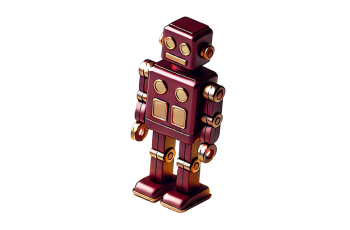AI's role in enhancing education

AI-generated images by Alex Davis/ASU
Editor's note: This feature article is part of our “AI is everywhere ... now what?” special project exploring the potential (and potential pitfalls) of artificial intelligence in our lives. Explore more topics and takes on the project page.
Professors at Arizona State University have been exploring the use of artificial intelligence for years, but when ChatGPT hit the scene in November 2022, even the early adopters had to pause.
“I was like, ‘What did we just do, and why did we do it?’" said Janel White-Taylor, a clinical professor in the Mary Lou Fulton Teachers College at ASU.
“And then I started playing with it, and I thought, ‘This is amazing,’
“And I remember the moment that I went from that fear to the excitement that this can really change the way we do the business of learning and school. And if we can embrace it properly, we can help a lot of students learn in the way that they want to learn.”
Mary Lou Fulton faculty are optimistic about AI easing the burden on overworked K–12 teachers by helping with lesson planning, grading and even special education. At the same time, they also are wary of potential challenges, such as disparity in access between wealthy and poor schools, and inherent biases in AI systems.
Teaching AI to students is not a matter of “if” but “when,” White-Taylor believes.
“It’s that initial fear of ‘What will this do to our society?’ But at the same time, if we don't teach students, what does that do for them?” she said.
“I think almost every job in the future is going to have some AI built into it. So the more they know how to leverage it, the better.”
A collaborative effort
The Mary Lou Fulton Teachers College started collaborating on the use of AI many years ago and has created a college-wide network of resources and support.
Punya Mishra, a professor and until recently the associate dean for scholarship and innovation, has worked in the field of education technology for more than 30 years. Years ago, he realized that AI would become huge and so became a driver of the college-wide Learning Futures Collaborative.
“The idea was that if this is a genuinely transformative technology, we need to bring everyone along,” he said.
“What was impressive to me is that our faculty approached it not as ‘students will cheat,’ but that their goal is to teach students how to use it correctly.”
Nearly 20 years ago, Mishra developed a framework called TPACK for how teachers learn to use technology in the classroom, and he recently wrote a new paper updating the concept. Applying the framework to generative AI, teachers must understand how it is different from other technologies and how to integrate it into their teaching. The change will be similar to the introduction of cheap calculators but with the added complexity of AI’s constant evolution.
And classrooms don’t operate in a vacuum. Mishra gives social media as an example. Fifteen years ago, teachers might have considered how to use platforms such as YouTube in the classroom but would never have imagined the societal changes wrought by social media that affect their students daily.
Mishra’s research has uncovered evidence of racial bias in AI. In one study, he and his colleagues presented two identical student writing samples to AI tools, with the only difference being the type of music the student listened to — rap versus classical. The AI rated the essay mentioning classical music higher and provided more sophisticated feedback.
“A human might even miss that. That’s not to say we shouldn’t use this, but let’s be aware,” Mishra said.
Harnessing 'super users'
AI is not yet widely used in K–12 classrooms, according to research done by Robin Lake, a professor of practice and the director of the Center on Reinventing Public Education at ASU. The center collaborated with the RAND Corporation last fall on a report about AI in the classroom, surveying more than 1,000 K–12 teachers and 231 districts. They found:
More educator resources
Leveraging OpenAI’s API platform, ASU Online has developed a collection of resources tailored for educators. These tools are crafted to streamline the creation of course materials, eliminating the necessity for in-depth expertise in prompt crafting or programming.
Learn more about the tools — including a question generator, a script voiceover and a rubric creator — at teachonline.asu.edu/asu-online-ai-tools.
- As of fall 2023, 18% of K–12 teachers surveyed used AI for teaching, and an additional 15% tried AI at least once.
- Social studies was the most popular subject AI was used for, and sixth through 12th grades the most common age group.
- Teachers with less than 10 years of experience were more likely to use AI than teachers with more experience.
- Teachers in suburban schools were more likely to use AI than those in urban or rural schools.
Of the 18% of teachers who reported using AI tools, these were the most common ways they used them: supporting students with learning differences; generating quizzes and assessments; adjusting content to an appropriate grade level; and generating lesson plans and assignments such as worksheets.
“Our interviews revealed that district leaders are quite optimistic about AI — in particular about how AI could help teachers save time,” Lake said.
“But they're worried about their ability to help teachers get up to speed,” she said, citing recovery from the pandemic and loss of funding from enrollment declines.
One finding is that suburban and more advantaged districts are already ahead in training teachers in AI.
“If there are benefits from these AI tools, we don't want them to accrue to the most advantaged schools,” she said.
Lake thinks that AI “super users” — the teachers who are early and eager adopters — can be an asset to their schools by sharing their knowledge.
“But we have to figure out how to compensate them and how to systematize that. And as a researcher, we need evidence building,” said Lake, whose center also is tracking state regulation of AI in education and building a database of early adopter districts.
Lake sees an interesting dynamic between the disruption wrought by the pandemic and the emergence of AI.
“One, there is a real sense of urgency around, ‘We need to find creative solutions because this is a lot harder than we thought.’ And resources are constrained and staffing continues to be a challenge. Teachers are burnt out, so what can we do to help them?” she said.
“And on the other side, I think a lot of people did not have a good experience with online learning during the pandemic. And a lot of people are very concerned about students' use of social media and cellphone usage.
“And so we're hearing that teachers are putting AI in a tech bundle that they don't trust.”
Centering Black girls
Tara Nkrumah, an assistant professor in the Mary Lou Fulton Teachers College, is getting ahead of potential inequity in AI. For three years, she has been collaborating with colleagues in Pittsburgh on a robotics program for Black girls ages 9 to 14. Last year, she received a National Science Foundation grant to expand the program into AI.
The goal is to have the girls be creators, not just consumers, of a product that would represent their voice and open a career pathway. The process would become a framework for creating equitable outcomes within AI for girls of color, Nkrumah said.
“It’s showing them that the content is more than just being able to succeed on exams or that they have expertise in terms of recall, but actually seeing the relevancy of AI in their everyday life and in ways they can use to speak to inequities and using AI as a tool to disrupt it,” she said.
Nkrumah is working on the professional development part of the project — training the facilitators who will work with the girls. A pilot study will begin this summer.
Her area of expertise is culturally relevant pedagogy, an educational framework to get kids engaged and empower them to create actions that promote equity.
Culturally relevant pedagogy shows that learning is more than succeeding on exams, she said.
“It’s about acknowledging the culture that the students bring to the space and validating that culture. And it's all about showing how academic success should not be standardized and that it should be understood in the ways in which each individual demonstrates their interests and their talents and their needs,” she said.
AI to amplify your voice
White-Taylor has helped to develop the AI Playground, a guide that curates AI resources across 11 categories that includes tips and tutorials.
She spends a lot of time, informally and formally, guiding classroom teachers in the use of AI, often by sharing how she uses it. She recently designed a course using several AI tools.
“We did some fun things, like videos with images created in Midjourney, an AI graphics tool.
“We wrote the initial script, we put it in ChatGPT, and said, ‘OK, make this sound more fun. Take out all the big words.’ And then we used voice generators to add the voiceover and then we put all that together.
“It’s really looking at ways for teachers to simplify.”
For example, AI could help teachers create writing rubrics.
“Not saying, ‘AI go in and create my rubric’ and then you're done. No, it gives you a nice rough draft to work from,” White-Taylor said.
AI also can help students who are hesitant writers.
“They struggle with that blank page,” she said.
“Being able to go into a tool and say, ‘I have to create an assignment on X, Y and Z. Where should I start?’ is a lot better than someone doing random Google searches.”
White-Taylor said it’s important to understand that AI tools will amplify your voice.
“You have to make sure that your voice is involved and that you're consciously and cautiously watching what's happening. Because it's not smart. You are,” she said.
AI is everywhere ... now what?
Artificial intelligence isn't just handy for creating images like the above — it has implications in an increasingly broad range of fields, from health to education to saving the planet.
Explore the ways in which ASU faculty are thinking about and using AI in their work:
- Enhancing education: ASU experts explain how artificial intelligence can help teachers — but training and access is key.
- A more sustainable future: Artificial intelligence is helping researchers find solutions to urgent worldwide issues.
- Advancing health care: AI has the potential to accelerate diagnoses and enable earlier and possibly life-saving treatment.
- The ethical costs: Issues around privacy, bias, surveillance and even extinction are raised with advancements in AI.
- Expert Q&As: Read smart minds' thoughts on everything from food security to the power grid to the legal system on our special project page.
More Arts, humanities and education

Upcoming exhibition brings experimental art and more to the West Valley campus
Ask Tra Bouscaren how he got into art and his answer is simple.“Art saved my life when I was 19,” he says. “I was in a dark place and art showed me the way out.”Bouscaren is an …

ASU professor, alum named Yamaha '40 Under 40' outstanding music educators
A music career conference that connects college students with such industry leaders as Timbaland. A K–12 program that incorporates technology into music so that students are using digital tools to…

ASU's Poitier Film School to host master classes, screening series with visionary filmmakers
Rodrigo Reyes, the acclaimed Mexican American filmmaker and Guggenheim Fellow whose 2022 documentary “Sansón and Me” won the Best Film Award at Sheffield DocFest, has built his career with films that…






